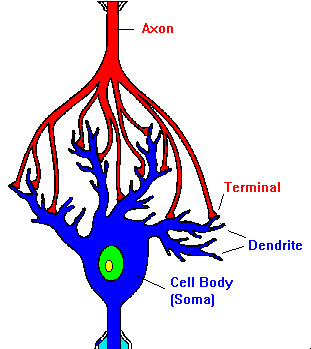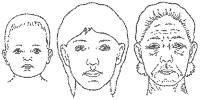 | Brain Plasticity: What Is
It? Learning and Memory |  |
Brain Plasticity--An Overview What is brain plasticity? Does it mean that our brains are
made of plastic? Of course not. Plasticity, or neuroplasticity,
describes how experiences reorganize neural pathways in the brain. Long
lasting functional changes in the brain occur when we learn new things or
memorize new information. These changes in neural connections are what we
call neuroplasticity.
What is brain plasticity? Does it mean that our brains are
made of plastic? Of course not. Plasticity, or neuroplasticity,
describes how experiences reorganize neural pathways in the brain. Long
lasting functional changes in the brain occur when we learn new things or
memorize new information. These changes in neural connections are what we
call neuroplasticity.To illustrate the concept of plasticity, imagine the film of a camera. Pretend that the film represents your brain. Now imagine using the camera to take a picture of a tree. When a picture is taken, the film is exposed to new information -- that of the image of a tree. In order for the image to be retained, the film must react to the light and "change" to record the image of the tree. Similarly, in order for new knowledge to be retained in memory, changes in the brain representing the new knowledge must occur. To illustrate plasticity in another way, imagine making an impression of a coin in a lump of clay. In order for the impression of the coin to appear in the clay, changes must occur in the clay -- the shape of the clay changes as the coin is pressed into the clay. Similarly, the neural circuitry in the brain must reorganize in response to experience or sensory stimulation.
Facts About NeuroplasticityFACT 1: Neuroplasticity includes several different processes that take place throughout a lifetime.Neuroplasticity does not consist of a single type of morphological change, but rather includes several different processes that occur throughout an individual's lifetime. Many types of brain cells are involved in neuroplasticity, including neurons, glia, and vascular cells.
Although plasticity occurs over an individual's lifetime, different types of plasticity dominate during certain periods of one's life and are less prevalent during other periods.
1. During normal brain development when the immature brain first begins to process sensory information through adulthood (developmental plasticity and plasticity of learning and memory). 2. As an adaptive mechanism to compensate for lost function and/or to maximize remaining functions in the event of brain injury.
FACT 4: The environment plays a key role in
influencing plasticity. In addition to genetic factors, the brain is shaped by the characteristics of a person's environment and by the actions of that same person.
Developmental Plasticity: Synaptic Pruning Gopnick et al. (1999) describe neurons as growing telephone wires that
communicate with one another. Following birth, the brain of a newborn is
flooded with information from the baby's sense organs.
Gopnick et al. (1999) describe neurons as growing telephone wires that
communicate with one another. Following birth, the brain of a newborn is
flooded with information from the baby's sense organs.  This sensory information must somehow make it back to the brain where it
can be processed. To do so, nerve cells must make connections with one
another, transmitting the impulses to the brain. Continuing with the
telephone wire analogy, like the basic telephone trunk lines strung
between cities, the newborn's genes instruct the "pathway" to the
correct area of the brain from a particular nerve cell. For example,
nerve cells in the retina of the eye send impulses to the primary visual
area in the occipital lobe of the brain and not to the area of language
production (Wernicke's area) in the left posterior temporal lobe. The
basic trunk lines have been established, but the specific connections
from one house to another require additional signals.
This sensory information must somehow make it back to the brain where it
can be processed. To do so, nerve cells must make connections with one
another, transmitting the impulses to the brain. Continuing with the
telephone wire analogy, like the basic telephone trunk lines strung
between cities, the newborn's genes instruct the "pathway" to the
correct area of the brain from a particular nerve cell. For example,
nerve cells in the retina of the eye send impulses to the primary visual
area in the occipital lobe of the brain and not to the area of language
production (Wernicke's area) in the left posterior temporal lobe. The
basic trunk lines have been established, but the specific connections
from one house to another require additional signals.Over the first few years of life, the brain grows rapidly. As each neuron matures, it sends out multiple branches (axons, which send information out, and dendrites, which take in information), increasing the number of synaptic contacts and laying the specific connections from house to house, or in the case of the brain, from neuron to neuron. At birth, each neuron in the cerebral cortex has approximately 2,500 synapses. By the time an infant is two or three years old, the number of synapses is approximately 15,000 synapses per neuron (Gopnick, et al., 1999). This amount is about twice that of the average adult brain. As we age, old connections are deleted through a process called synaptic pruning. Synaptic pruning eliminates weaker synaptic contacts while stronger connections are kept and strengthened. Experience determines which connections will be strengthened and which will be pruned; connections that have been activated most frequently are preserved. Neurons must have a purpose to survive. Without a purpose, neurons die through a process called apoptosis in which neurons that do not receive or transmit information become damaged and die. Ineffective or weak connections are "pruned" in much the same way a gardener would prune a tree or bush, giving the plant the desired shape. It is plasticity that enables the process of developing and pruning connections, allowing the brain to adapt itself to its environment. Plasticity of Learning and MemoryIt was once believed that as we aged, the brain's networks became fixed. In the past two decades, however, an enormous amount of research has revealed that the brain never stops changing and adjusting. Learning, as defined by Tortora and Grabowski (1996), is the ability
to acquire new knowledge or skills through instruction or experience.
Memory is the process by which that knowledge is retained over time. The
capacity of the brain to change with learning is plasticity. So how does
the brain change with learning? According to Durbach (2000), there appear
to be at least two types of modifications that occur in the brain with
learning:
Learning, as defined by Tortora and Grabowski (1996), is the ability
to acquire new knowledge or skills through instruction or experience.
Memory is the process by which that knowledge is retained over time. The
capacity of the brain to change with learning is plasticity. So how does
the brain change with learning? According to Durbach (2000), there appear
to be at least two types of modifications that occur in the brain with
learning:
Initially, newly learned data are "stored" in short-term memory, which is a temporary ability to recall a few pieces of information. Some evidence supports the concept that short-term memory depends upon electrical and chemical events in the brain as opposed to structural changes such as the formation of new synapses. One theory of short-term memory states that memories may be caused by "reverberating" neuronal circuits -- that is, an incoming nerve impulse stimulates the first neuron which stimulates the second, and so on, with branches from the second neuron synapsing with the first. After a period of time, information may be moved into a more permanent type of memory, long-term memory, which is the result of anatomical or biochemical changes that occur in the brain (Tortora and Grabowski, 1996). Injury-induced Plasticity: Plasticity and Brain RepairDuring brain repair following injury, plastic changes are geared towards maximizing function in spite of the damaged brain. In studies involving rats in which one area of the brain was damaged, brain cells surrounding the damaged area underwent changes in their function and shape that allowed them to take on the functions of the damaged cells. Although this phenomenon has not been widely studied in humans, data indicate that similar (though less effective) changes occur in human brains following injury. |
They said
it! | "The principal activities of brains are making
changes in themselves." --Marvin L. Minsky (from Society of the Mind, 1986) |
 For references and more
information on neuroplasticity, see: For references and more
information on neuroplasticity, see:
General Memory Sites:
|
| BACK TO: | Exploring the Nervous System | Table of Contents |
![[email]](./gif/menue.gif) Send E-mail |
 Get Newsletter |
 Search Pages |
 Donate to Neuroscience for Kids |
Page prepared by Erin Hoiland
Neuroscience for Kids Consultant
Edited by Eric H. Chudler, Ph.D.

 FACT 2: Neuroplasticity has a clear
age-dependent determinant.
FACT 2: Neuroplasticity has a clear
age-dependent determinant.